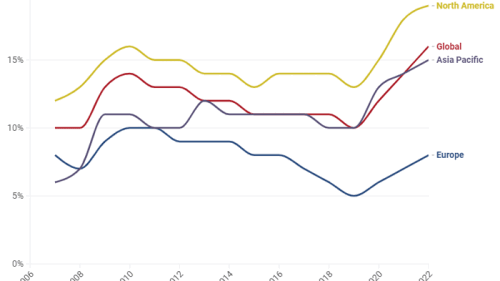In other times, Houston’s economic performance in 2014 would have been considered outstanding. Sales of existing homes hit a record high. Houston ranked among the nation’s leaders in job growth, and construction permits soared to the highest annual total ever. Unemployment was down. Exports were up.
But despite those strong results, no euphoria spills from the lips of Houston economists today. Caution rules in the business community.
A dark blot casts a shadow over Houston’s economy. It’s oil.
As summer 2014 ended, the price of oil dropped steadily, punctuated by a precipitous 10 percent tumble on the day after Thanksgiving. Then, things got even worse.
West Texas Intermediate, the benchmark price for U.S. crude oil, fell from a high of $108 a barrel in June, to below $45 by January 2015.
In Houston—called the Energy Capital of the World—when oil drops that far and that fast, shockwaves affect the local economy quickly. On the surface, many sectors still appear to be healthy, but memories of the economic devastation of the 1980s oil bust rekindle old nightmares whenever oil prices fall.
In recent months, energy giants including Halliburton, ConocoPhillips, Weatherford, and Baker Hughes, to name a few, have announced major layoffs in Houston and throughout the world’s oil fields. Other energy firms, including Marathon Oil and Anadarko Petroleum, have sliced billions off their 2015 budgets for drilling new wells.
The Baker Hughes rig count, a measurement of drilling rigs operating in the United States, had dropped to a five-year low by early March, with 1,192 rigs in operation, down 33 percent from a year earlier.
“The pause button has been hit,” says Dan Bellow, president of Jones Lang LaSalle–Houston, a commercial real estate firm representing a number of major energy clients. “Nobody knows how low the price is going to go or how long this is going to last.”
Even though some sectors are still strong, Houston’s real estate industry has already felt aftershocks from energy’s fall.
In the Houston area, 50 proposed multifamily projects have been postponed indefinitely or killed outright since oil plummeted, according to the Colliers International real estate firm.
Although the city’s retail, industrial, and land development sectors remain healthy, recently a number of lenders redlined parts of Houston’s multifamily and office markets, turning off the flow of new construction loans for speculative projects.
In early 2015, more than 1 million square feet (93,000 sq m) of excess office space was dumped back on the Houston market for sublease as energy companies retreated from expansion plans. Some say the city’s overall office vacancy rate, now a relatively healthy 11 percent, will be rising, putting pressure on landlords to lower rents.
The impact of falling oil prices goes far beyond real estate. Every Houstonian—from the steelworker at the Port of Houston to the doctor at the massive Texas Medical Center to the engineer in a new office tower in west Houston’s Energy Corridor—is talking about the collapse of oil prices and knows what it could mean.
The Houston Chronicle, the city’s largest newspaper, runs a daily information box at the top of its front page carrying a green arrow pointing up or a red arrow pointing down indicating the price fluctuations of West Texas Intermediate crude oil—the lifeblood of the city’s economy. The whole city is watching, and nobody knows what will happen next.
“A lot of people are sitting on their hands, waiting to see what’s going to happen,” says Patrick Jankowski, senior vice president and regional economist for the Greater Houston Partnership, an economic development organization. “We are in this huge period of uncertainty.”
Jankowski says the current correction will not rival Houston’s downfall in the 1980s, when oil dropped to $10 a barrel. The oil business shriveled, and by the end of 1986 it was clear the crash had robbed Houston of 220,000 jobs over a four-year period. Waves of foreclosures rolled in and Houston home prices plummeted. Hundreds of Texas banks and savings and loans institutions failed.
Houston’s commercial real estate markets paid the price for the gross overbuilding of that era. About 71 million square feet (6.7 million sq m) of office space was built between 1982 and 1986. When the construction spree ended, Houston was left with an ugly supply of what cynics called “see-through” office space—brand-new buildings that sat vacant for years. Houston’s office vacancy rate soared above 30 percent.
“We are not going to repeat the 1980s,” Jankowski says.
The current slide is mild in comparison. The Houston economy gained 104,700 jobs in 2014, and most of the region’s forecasters are projecting around 50,000 jobs will be created in 2015.
With growth in health care and petrochemicals, Houston’s economy is much more diversified now, with some 38 percent of the economy dependent on energy, down from the early 1980s when over three-fourths of the economy was estimated to be tied to energy in some respect, Jankowski says.
A great revival in the nation’s energy industry began about five years ago as new methods of oil exploration, such as horizontal drilling and hydraulic fracturing, were brought to market. The new methods allowed energy firms to tap into shale formations and draw rich oil and gas that had been unreachable.
As the shale boom was uncorked, new parts of the nation became oil-patch powerhouses. Drilling permits for work in the Eagle Ford Shale formation near San Antonio jumped from only 94 issued in 2009 to 5,613 in 2014, according to the Texas Railroad Commission, which regulates the energy industry.
Over the past five years, the shale boom invigorated hiring in Houston’s manufacturing complex, where workers labored overtime to produce drill bits, valves, and oil tools. Energy firms and engineering companies that serve the industry snapped up Houston office space. Occupancy in the Energy Corridor’s prime buildings reached 99 percent, and rents shot up across the city.
Construction of office buildings soared. Houston led the nation at year-end 2014 with 50 buildings, totaling 17 million square feet (1.6 million sq m), under construction, according to CBRE Research.
Some projects are speculative, including the 1 million-square-foot (93,000 sq m) tower being developed by Hines Interests on Main Street in downtown Houston. About 65 percent of the new space in the city is already leased, CBRE reports.
But in this new era of lower oil prices, new office projects will be a rarity in Houston.
“Speculative office projects won’t happen. You’re going to need a tenant to start off a building,” says Kevin Roberts, president of the southwest region of the Transwestern commercial real estate firm. “The new supply will be halted.”
Houston commercial construction company Arch-Con Corporation will remain exceptionally busy in 2015, although the future could be a bit bumpy, says company president Michael Scheurich.
“Our firm must deal with a larger volume of work in the short term but prepare for a slowdown in 2016,” Scheurich says. He is planning to expand Arch-Con operations outside Texas and diversify beyond the energy sector into seniors’ housing and medical construction.
“I guess there is a general vibe about the market that’s a little bit depressing,” says architect Dean Strombom, principal and energy practice leader at the Houston offices of the Gensler architecture firm. “But it’s really more about feeling than it is actual impact on our workload—yet. It seems like we can sort of see a downturn coming. But right now we remain busy, and everybody I talk to in the construction/design industry is busy.”
Commercial brokerage firms anticipate more moderate results as the Houston market settles down and more tenants play it conservatively by taking shorter leases, says Paul Coonrod, managing director in Stream Realty’s Houston office.
“You will see shorter terms being signed this year because of a lack of confidence in the energy markets,” Coonrod says. “Rather than doing a ten-year lease renewal, you are going to see some companies just do a year’s extension or just a three- or five-year deal.”
Although some sectors crumble in the low-energy-price environment, the chemical industry gains momentum as prices decline for its primary feedstock. Four major ethylene plants, which will produce raw plastic to be shipped to manufacturers around the world, are now under construction in the Houston area by some of the biggest names in the industry—ChevronPhillips, ExxonMobil, Dow Chemical, and Formosa Plastics.
The huge ethylene plants, with a combined $18 billion in construction costs, are creating some 26,000 construction jobs, and the four plants will not be completed until 2017.
Houston’s industrial activity is also gaining a charge from the Port of Houston. A major expansion of the Panama Canal, scheduled for completion in 2016, will allow larger ships to move cargo to and from Houston to the Asia Pacific region.
“I’m very bullish about the port,” says Trey Odom, president of Avera Cos., a Houston firm that develops warehouses and industrial properties.
Avera just completed the 600,000-square-foot (56,000 sq m) 225RailPort distribution center, which is fully leased, and more projects are planned, including a 1.2 million-square-foot (115,000 sq m) distribution center slated to start construction in 2016, Odom says.
“What we are seeing in the Houston industrial market is unbelievable activity,” Odom says. “We are about to make several big deals.”
Houston recorded a record 8.1 million square feet (753,000 sq m) of net absorption of industrial space in 2014, and vacancy remains low, according to CBRE.
The city’s residential markets, boosted by job growth and population gains, have continued their outstanding performance, although the multifamily market is poised to cool off after more than 17,000 units were completed in 2014.
Sales of existing homes in Houston hit a record high in 2014 with 75,319 single-family homes sold, and the inventory of homes for sale was exceptionally tight, at only a 2.6 months’ supply, according to the Houston Association of Realtors.
The northern part of the Houston area was lifted by ExxonMobil’s new 3 million-square-foot (279,000 sq m) campus and the development of a 38-mile (61 km) extension of the Grand Parkway—a third loop highway around the Houston metropolitan area—which opened up great swaths of land for development.
Homebuilders, which have been held back in recent years by a lack of lots and labor, are starting to overcome those problems.
“We’re coming off three years in a row of adding 100,000-plus jobs a year,” says Scott Davis, Houston regional director of Metrostudy, a housing analytics firm. “We’ve been in a period where we have been supply constrained, and we are starting to catch up with that.”
Houston was the leading market in the nation for single-family construction last year, with more than 30,000 starts, Davis says, and it will remain a strong market this year, despite the slide in energy prices. Metrostudy forecasts a 5 to 6 percent increase in starts for 2015.
One side effect of lower energy prices has been positive for homebuilders, Davis says: builders are reporting that lower gasoline prices have reduced a barrier for consumers who are considering long commutes from new homes in the outer suburbs.
Despite challenges and damage caused by a 50 percent decline in oil prices, optimism continues to bubble up in Houston: the owner of Houston’s Gallery Furniture, Jim “Mattress Mack” McIngvale, known for his flamboyant television advertisements, is eagerly promising to give customers complete refunds on their furniture purchases—if oil prices start rising again and close above $85 a barrel on Dec. 31, 2015. The overly optimistic customers hoping for such a price revival this year likely will be very disappointed. The U.S. Energy Information Administration forecasts an average West Texas Intermediate price of $56 a barrel in 2015 and $71 a barrel in 2016.
Houstonian Michelle Michot Foss, chief energy economist for the Bureau of Economic Geology’s Center for Energy Economics at the University of Texas, says $50 a barrel seems like a likely price for 2015, although a more severe price decline is not out of the question.
The prospects are solid for energy in the United States because risk and uncertainty surround energy production in Russia, Mexico, and Brazil, Foss says.
“That pretty much leaves the lower 48 as the most comfortable territory,” Foss says, “and Houston still as the center.”
Ralph Bivins, a Texas journalist, is editor of Realty News Report.






